Estimating Crop LAI Using Spectral Feature Extraction and the Hybrid Inversion Method
Abstract
1. Introduction
2. Materials and Methods
2.1. Simulated Dataset of PROSAIL Model
2.2. Spectral Information Extraction
2.3. Regression Model Construction
2.4. Ground Observation Experiment and Validation Dataset
2.5. LAI Inversion Flow Chart
3. Results and Analysis
3.1. Spectral Feature Information Extraction for LAI Estimation
3.1.1. Appropriate PCs for LAI Estimation
3.1.2. Selection of Vegetation Indices for LAI Estimation
3.2. LAI Inversion Modeling for CHRIS
3.2.1. Model Construction and Anti-Noise Evaluation
3.2.2. The Contribution of Spectral Bands to PCs
3.3. Model Validation with the CHRIS Data
3.3.1. Image Feature and Crop-Covered Area Extraction
3.3.2. LAI Remote Sensing Mapping and Accuracy Evaluation
4. Discussion
5. Conclusions
Author Contributions
Funding
Acknowledgments
Conflicts of Interest
Appendix A
| Vegetation Index | Formulation | References |
|---|---|---|
| NDVI705 | [98,99] | |
| mNDVI705 | [100,101] | |
| mSR705 | [100,101] | |
| GNDVI | [102] | |
| RDVI | [103] | |
| NDCI | [104] | |
| Datt1 | [100] | |
| Datt2 | ||
| Carte1 | [105] | |
| Carte2 | ||
| Carte3 | ||
| Carte4 | ||
| Carte5 | ||
| NVI | [106] | |
| EVI | [107,108] | |
| OSAVI | [109] | |
| TVI | [91] | |
| MTVI1 | [90] | |
| MTVI2 | [90] | |
| SPVI | [110,111] | |
| SPVI2 | [111] | |
| REP | [112] | |
| PRI | [113] | |
| VOG1 | [114] | |
| VOG2 | ||
| VOG3 |
References
- Yin, G.; Li, A.; Jin, H.; Zhao, W.; Bian, J.; Qu, Y.; Zeng, Y.; Xu, B. Derivation of temporally continuous LAI reference maps through combining the LAINet observation system with CACAO. Agric. For. Meteorol. 2017, 233, 209–221. [Google Scholar] [CrossRef]
- Kira, O.; Nguy-Robertson, A.L.; Arkebauer, T.J.; Linker, R.; Gitelson, A.A. Informative spectral bands for remote green LAI estimation in C3 and C4 crops. Agric. For. Meteorol. 2016, 218, 243–249. [Google Scholar] [CrossRef]
- Liang, L.; Di, L.; Zhang, L.; Deng, M.; Qin, Z.; Zhao, S.; Lin, H. Estimation of crop LAI using hyperspectral vegetation indices and a hybrid inversion method. Remote Sens. Environ. 2015, 165, 123–134. [Google Scholar] [CrossRef]
- Laurent, V.C.; Schaepman, M.E.; Verhoef, W.; Weyermann, J.; Chávez, R.O. Bayesian object-based estimation of LAI and chlorophyll from a simulated Sentinel-2 top-of-atmosphere radiance image. Remote Sens. Environ. 2014, 140, 318–329. [Google Scholar] [CrossRef]
- Liu, Y.; Ju, W.; Chen, J.; Zhu, G.; Xing, B.; Zhu, J.; He, M. Spatial and temporal variations of forest LAI in China during 2000–2010. Chin. Sci. Bull. 2012, 57, 2846–2856. [Google Scholar] [CrossRef]
- Houborg, R.; Soegaard, H.; Boegh, E. Combining vegetation index and model inversion methods for the extraction of key vegetation biophysical parameters using Terra and Aqua MODIS reflectance data. Remote Sens. Environ. 2007, 106, 39–58. [Google Scholar] [CrossRef]
- Pu, R.; Landry, S. Evaluating seasonal effect on forest leaf area index mapping using multi-seasonal high resolution satellite pléiades imagery. Int. J. Appl. Earth Obs. Geoinf. 2019, 80, 268–279. [Google Scholar] [CrossRef]
- Zhao, C.; Li, H.; Li, P.; Yang, G.; Gu, X.; Lan, Y. Effect of vertical distribution of crop structure and biochemical parameters of winter wheat on canopy reflectance characteristics and spectral indices. IEEE Trans. Geosci. Remote Sens. 2016, 55, 236–247. [Google Scholar] [CrossRef]
- Pu, R.; Cheng, J. Mapping forest leaf area index using reflectance and textural information derived from WorldView-2 imagery in a mixed natural forest area in Florida, US. Int. J. Appl. Earth Obs. Geoinf. 2015, 42, 11–23. [Google Scholar] [CrossRef]
- Wang, D.; Liang, S. Improving LAI mapping by integrating MODIS and CYCLOPES LAI products using optimal interpolation. IEEE J. Sel. Top. Appl. Earth Obs. Remote Sens. 2013, 7, 445–457. [Google Scholar] [CrossRef]
- Fang, H.; Wei, S.; Liang, S. Validation of MODIS and CYCLOPES LAI products using global field measurement data. Remote Sens. Environ. 2012, 119, 43–54. [Google Scholar] [CrossRef]
- Le Maire, G.; Marsden, C.; Verhoef, W.; Ponzoni, F.J.; Seen, D.L.; Bégué, A.; Stape, J.-L.; Nouvellon, Y. Leaf area index estimation with MODIS reflectance time series and model inversion during full rotations of Eucalyptus plantations. Remote Sens. Environ. 2011, 115, 586–599. [Google Scholar] [CrossRef]
- Ryu, C.; Suguri, M.; Umeda, M. Model for predicting the nitrogen content of rice at panicle initiation stage using data from airborne hyperspectral remote sensing. Biosyst. Eng. 2009, 104, 465–475. [Google Scholar] [CrossRef]
- Liang, L.; Yang, M.; Zhang, L.; Lin, H.; Zhou, X. Chlorophyll content inversion with hyperspectral technology for wheat canopy based on support vector regression algorithm. Trans. Chin. Soc. Agric. Eng. 2012, 28, 162–171. [Google Scholar]
- Liang, L.; Huang, T.; Di, L.; Geng, D.; Yan, J.; Wang, S.; Wang, L.; Li, L.; Chen, B.; Kang, J. Influence of different bandwidths on LAI estimation using vegetation indices. EEE J. Sel. Top. Appl. Earth Obs. Remote Sens. 2020, 13, 1494–1502. [Google Scholar] [CrossRef]
- Darvishzadeh, R.; Skidmore, A.; Schlerf, M.; Atzberger, C.; Corsi, F.; Cho, M. LAI and chlorophyll estimation for a heterogeneous grassland using hyperspectral measurements. ISPRS J. Photogramm. Remote Sens. 2008, 63, 409–426. [Google Scholar] [CrossRef]
- Pu, R.; Gong, P. Wavelet transform applied to EO-1 hyperspectral data for forest LAI and crown closure mapping. Remote Sens. Environ. 2004, 91, 212–224. [Google Scholar] [CrossRef]
- Kötz, B.; Schaepman, M.; Morsdorf, F.; Bowyer, P.; Itten, K.; Allgöwer, B. Radiative transfer modeling within a heterogeneous canopy for estimation of forest fire fuel properties. Remote Sens. Environ. 2004, 92, 332–344. [Google Scholar] [CrossRef]
- Lin, H.; Liang, L.; Zhang, L.; Du, P. Wheat leaf area index inversion with hyperspectral remote sensing based on support vector regression algorithm. Trans. Chin. Soc. Agric. Eng. 2013, 29, 139–146. [Google Scholar]
- Verrelst, J.; Camps-Valls, G.; Muñoz-Marí, J.; Rivera, J.P.; Veroustraete, F.; Clevers, J.G.; Moreno, J. Optical remote sensing and the retrieval of terrestrial vegetation bio-geophysical properties—A review. ISPRS J. Photogramm. Remote Sens. 2015, 108, 273–290. [Google Scholar] [CrossRef]
- Verger, A.; Baret, F.; Camacho, F. Optimal modalities for radiative transfer-neural network estimation of canopy biophysical characteristics: Evaluation over an agricultural area with CHRIS/PROBA observations. Remote Sens. Environ. 2011, 115, 415–426. [Google Scholar] [CrossRef]
- Jacquemoud, S.; Verhoef, W.; Baret, F.; Bacour, C.; Zarco-Tejada, P.J.; Asner, G.P.; François, C.; Ustin, S.L. PROSPECT+ SAIL models: A review of use for vegetation characterization. Remote Sens. Environ. 2009, 113, S56–S66. [Google Scholar] [CrossRef]
- Xu, X.; Lu, J.; Zhang, N.; Yang, T.; He, J.; Yao, X.; Cheng, T.; Zhu, Y.; Cao, W.; Tian, Y. Inversion of rice canopy chlorophyll content and leaf area index based on coupling of radiative transfer and Bayesian network models. ISPRS J. Photogramm. Remote Sens. 2019, 150, 185–196. [Google Scholar] [CrossRef]
- Darvishzadeh, R.; Wang, T.; Skidmore, A.; Vrieling, A.; O’Connor, B.; Gara, T.W.; Ens, B.J.; Paganini, M. Analysis of Sentinel-2 and RapidEye for retrieval of leaf area index in a saltmarsh using a Radiative Transfer Model. Remote Sens. 2019, 11, 671. [Google Scholar] [CrossRef]
- Si, Y.; Schlerf, M.; Zurita-Milla, R.; Skidmore, A.; Wang, T. Mapping spatio-temporal variation of grassland quantity and quality using MERIS data and the PROSAIL model. Remote Sens. Environ. 2012, 121, 415–425. [Google Scholar] [CrossRef]
- Verrelst, J.; Malenovský, Z.; Van der Tol, C.; Camps-Valls, G.; Gastellu-Etchegorry, J.-P.; Lewis, P.; North, P.; Moreno, J. Quantifying vegetation biophysical variables from imaging spectroscopy data: A review on retrieval methods. Surv. Geophys. 2019, 40, 589–629. [Google Scholar] [CrossRef]
- Liang, L.; Qin, Z.; Zhao, S.; Di, L.; Zhang, C.; Deng, M.; Lin, H.; Zhang, L.; Wang, L.; Liu, Z. Estimating crop chlorophyll content with hyperspectral vegetation indices and the hybrid inversion method. Int. J. Remote Sens. 2016, 37, 2923–2949. [Google Scholar] [CrossRef]
- Peng, Y.; Gitelson, A.A. Remote estimation of gross primary productivity in soybean and maize based on total crop chlorophyll content. Remote Sens. Environ. 2012, 117, 440–448. [Google Scholar] [CrossRef]
- Botha, E.; Leblon, B.; Zebarth, B.; Watmough, J. Non-destructive estimation of wheat leaf chlorophyll content from hyperspectral measurements through analytical model inversion. Int. J. Remote Sens. 2010, 31, 1679–1697. [Google Scholar] [CrossRef]
- Liang, S. Quantitative Remote Sensing of Land Surfaces; John Wiley & Sons: Hoboken, NJ, USA, 2005; Volume 30. [Google Scholar]
- Liang, L.; Di, L.; Huang, T.; Wang, J.; Lin, L.; Wang, L.; Yang, M. Estimation of leaf nitrogen content in wheat using new hyperspectral indices and a random forest regression algorithm. Remote Sens. 2018, 10, 1940. [Google Scholar] [CrossRef]
- Houborg, R.; McCabe, M.F. A hybrid training approach for leaf area index estimation via Cubist and random forests machine-learning. ISPRS J. Photogramm. Remote Sens. 2018, 135, 173–188. [Google Scholar] [CrossRef]
- Chlingaryan, A.; Sukkarieh, S.; Whelan, B. Machine learning approaches for crop yield prediction and nitrogen status estimation in precision agriculture: A review. Comput. Electron. Agric. 2018, 151, 61–69. [Google Scholar] [CrossRef]
- Gong, P. Inverting a canopy reflectance model using a neural network. Int. J. Remote Sens. 1999, 20, 111–122. [Google Scholar] [CrossRef]
- Fang, H.; Liang, S. A hybrid inversion method for mapping leaf area index from MODIS data: Experiments and application to broadleaf and needleleaf canopies. Remote Sens. Environ. 2005, 94, 405–424. [Google Scholar] [CrossRef]
- Yue, J.; Yang, G.; Tian, Q.; Feng, H.; Xu, K.; Zhou, C. Estimate of winter-wheat above-ground biomass based on UAV ultrahigh-ground-resolution image textures and vegetation indices. ISPRS J. Photogramm. Remote Sens. 2019, 150, 226–244. [Google Scholar] [CrossRef]
- Xu, M.; Liu, R.; Chen, J.M.; Liu, Y.; Shang, R.; Ju, W.; Wu, C.; Huang, W. Retrieving leaf chlorophyll content using a matrix-based vegetation index combination approach. Remote Sens. Environ. 2019, 224, 60–73. [Google Scholar] [CrossRef]
- Cui, B.; Zhao, Q.; Huang, W.; Song, X.; Ye, H.; Zhou, X. A new integrated vegetation index for the estimation of winter wheat leaf chlorophyll content. Remote Sens. 2019, 11, 974. [Google Scholar] [CrossRef]
- Campos-Taberner, M.; García-Haro, F.J.; Camps-Valls, G.; Grau-Muedra, G.; Nutini, F.; Crema, A.; Boschetti, M. Multitemporal and multiresolution leaf area index retrieval for operational local rice crop monitoring. Remote Sens. Environ. 2016, 187, 102–118. [Google Scholar] [CrossRef]
- Paz Pellat, F.; Romero Sanchez, M.E.; Palacios Vélez, E.; Bolaños González, M.; Valdez Lazalde, J.R.; Aldrete, A. Alcances y limitaciones de los índices espectrales de la vegetación: Análisis de índices de banda ancha. Terra Latinoam. 2015, 33, 27–49. [Google Scholar]
- Meng, S.; Huang, L.-T.; Wang, W.-Q. Tensor decomposition and PCA jointed algorithm for hyperspectral image denoising. IEEE Geosci. Remote Sens. Lett. 2016, 13, 897–901. [Google Scholar] [CrossRef]
- Licciardi, G.A.; Chanussot, J. Nonlinear PCA for visible and thermal hyperspectral images quality enhancement. IEEE Geosci. Remote Sens. Lett. 2015, 12, 1228–1231. [Google Scholar] [CrossRef]
- Conforti, M.; Castrignanò, A.; Robustelli, G.; Scarciglia, F.; Stelluti, M.; Buttafuoco, G. Laboratory-based Vis–NIR spectroscopy and partial least square regression with spatially correlated errors for predicting spatial variation of soil organic matter content. Catena 2015, 124, 60–67. [Google Scholar] [CrossRef]
- Le Maire, G.; François, C.; Soudani, K.; Berveiller, D.; Pontailler, J.-Y.; Bréda, N.; Genet, H.; Davi, H.; Dufrêne, E. Calibration and validation of hyperspectral indices for the estimation of broadleaved forest leaf chlorophyll content, leaf mass per area, leaf area index and leaf canopy biomass. Remote Sens. Environ. 2008, 112, 3846–3864. [Google Scholar] [CrossRef]
- Verhoef, W.; Jia, L.; Xiao, Q.; Su, Z. Unified optical-thermal four-stream radiative transfer theory for homogeneous vegetation canopies. IEEE Trans. Geosci. Remote Sens. 2007, 45, 1808–1822. [Google Scholar] [CrossRef]
- Bowyer, P.; Danson, F. Sensitivity of spectral reflectance to variation in live fuel moisture content at leaf and canopy level. Remote Sens. Environ. 2004, 92, 297–308. [Google Scholar] [CrossRef]
- Weiss, M.; Troufleau, D.; Baret, F.; Chauki, H.; Prevot, L.; Olioso, A.; Bruguier, N.; Brisson, N. Coupling canopy functioning and radiative transfer models for remote sensing data assimilation. Agric. For. Meteorol. 2001, 108, 113–128. [Google Scholar] [CrossRef]
- Wang, M. Research of Vegetation Hybrid Inversion with Hyperspectral Data Based on Transform Algorithm; Jiangsu Normal University: Xuzhou, China, 2013; pp. 26–28. [Google Scholar]
- Feret, J.-B.; François, C.; Asner, G.P.; Gitelson, A.A.; Martin, R.E.; Bidel, L.P.; Ustin, S.L.; Le Maire, G.; Jacquemoud, S. PROSPECT-4 and 5: Advances in the leaf optical properties model separating photosynthetic pigments. Remote Sens. Environ. 2008, 112, 3030–3043. [Google Scholar] [CrossRef]
- Atzberger, C. Object-based retrieval of biophysical canopy variables using artificial neural nets and radiative transfer models. Remote Sens. Environ. 2004, 93, 53–67. [Google Scholar] [CrossRef]
- Weiss, M.; Baret, F. Evaluation of canopy biophysical variable retrieval performances from the accumulation of large swath satellite data. Remote Sens. Environ. 1999, 70, 293–306. [Google Scholar] [CrossRef]
- Combal, B.; Baret, F.; Weiss, M.; Trubuil, A.; Mace, D.; Pragnere, A.; Myneni, R.; Knyazikhin, Y.; Wang, L. Retrieval of canopy biophysical variables from bidirectional reflectance: Using prior information to solve the ill-posed inverse problem. Remote Sens. Environ. 2003, 84, 1–15. [Google Scholar] [CrossRef]
- Liu, L.; Wang, J.; Huang, W.; Zhao, C. Detection of leaf and canopy EWT by calculating REWT from reflectance spectra. Int. J. Remote Sens. 2010, 31, 2681–2695. [Google Scholar] [CrossRef]
- Vohland, M.; Jarmer, T. Estimating structural and biochemical parameters for grassland from spectroradiometer data by radiative transfer modelling (PROSPECT + SAIL). Int. J. Remote Sens. 2008, 29, 191–209. [Google Scholar] [CrossRef]
- Darvishzadeh, R.; Skidmore, A.; Schlerf, M.; Atzberger, C. Inversion of a radiative transfer model for estimating vegetation LAI and chlorophyll in a heterogeneous grassland. Remote Sens. Environ. 2008, 112, 2592–2604. [Google Scholar] [CrossRef]
- Bacour, C.; Baret, F.; Béal, D.; Weiss, M.; Pavageau, K. Neural network estimation of LAI, fAPAR, fCover and LAI× Cab, from top of canopy MERIS reflectance data: Principles and validation. Remote Sens. Environ. 2006, 105, 313–325. [Google Scholar] [CrossRef]
- Brockmann, C. Sentinel-3 Experimental Campaign, Final Report; European Space Agency: Paris, France, 2011. [Google Scholar]
- Fu, P.; Sun, Q.; Ji, Z. A spectral-spatial information based approach for the mixed noise estimation from hyperspectral remote sensing images. J. Infrared Millim. Waves 2015, 34, 236–242. [Google Scholar]
- Meola, J.; Eismann, M.T.; Moses, R.L.; Ash, J.N. Modeling and estimation of signal-dependent noise in hyperspectral imagery. Appl. Opt. 2011, 50, 3829–3846. [Google Scholar] [CrossRef] [PubMed]
- Acito, N.; Diani, M.; Corsini, G. Signal-dependent noise modeling and model parameter estimation in hyperspectral images. IEEE Trans. Geosci. Remote Sens. 2011, 49, 2957–2971. [Google Scholar] [CrossRef]
- Shen, Q.; Zhang, B.; Li, J.-S.; Zhang, X.; Zhang, X.-Y. Atmospheric correction for waterbody images acquired by spaceborne hyperspectral sensor CHRIS. Cehui Xuebao/Acta Geod. Cartogr. Sin. 2008, 37, 476–481+488. [Google Scholar]
- Barducci, A.; Guzzi, D.; Marcoionni, P.; Pippi, I. CHRIS-Proba performance evaluation: Signal-to-noise ratio, instrument efficiency and data quality from acquisitions over San Rossore (Italy) test site. In Proceedings of the 3rd ESA CHRIS/Proba Workshop, Frascati, Italy, 21–23 March 2005. [Google Scholar]
- Mannheim, S.; Segl, K.; Heim, B.; Kaufmann, H. Monitoring of lake water quality using hyperspectral CHRIS-PROBA data. In Proceedings of the 2nd CHRIS/PROBA Workshop, Frascati, Italy, 28–30 April 2004; pp. 28–30. [Google Scholar]
- Garcia, J.; Moreno, J. Removal of noises in CHRIS/Proba images: Application to the SPARC campaign data. In Proceedings of the 2nd CHRIS/Proba Workshop, ESA/ERSIN, Frascati, Italy, 28–30 April 2004; pp. 29–33. [Google Scholar]
- Liang, L.; Yang, M.; Deng, K.; Zhang, L.; Lin, H.; Liu, Z. A new hyperspectral index for the estimation of nitrogen contents of wheat canopy. Acta Ecol. Sin. 2011, 31, 6594–6605. [Google Scholar]
- Jolliffe, I. Principal component analysis. Technometrics 2003, 45, 276. [Google Scholar]
- Huemmrich, K.F.; Campbell, P.K.E.; Gao, B.-C.; Flanagan, L.B.; Goulden, M. ISS as a platform for optical remote sensing of ecosystem carbon fluxes: A case study using HICO. IEEE J. Sel. Top. Appl. Earth Obs. Remote Sens. 2017, 10, 4360–4375. [Google Scholar] [CrossRef]
- Henseler, J.; Hubona, G.; Ray, P.A. Using PLS path modeling in new technology research: Updated guidelines. Ind. Manag. Data Syst. 2016, 116, 2–20. [Google Scholar] [CrossRef]
- Mehmood, T.; Bohlin, J.; Snipen, L. A partial least squares based procedure for upstream sequence classification in prokaryotes. IEEE/ACM Trans. Comput. Biol. Bioinform. 2014, 12, 560–567. [Google Scholar] [CrossRef] [PubMed]
- Asner, G.P.; Martin, R.E.; Knapp, D.E.; Tupayachi, R.; Anderson, C.; Carranza, L.; Martinez, P.; Houcheime, M.; Sinca, F.; Weiss, P. Spectroscopy of canopy chemicals in humid tropical forests. Remote Sens. Environ. 2011, 115, 3587–3598. [Google Scholar] [CrossRef]
- Rossel, R.V. Robust modelling of soil diffuse reflectance spectra by “bagging-partial least squares regression”. J. Near Infrared Spectrosc. 2007, 15, 39–47. [Google Scholar] [CrossRef]
- Abdi, H. Partial least squares regression and projection on latent structure regression (PLS Regression). Wiley Interdiscip. Rev. Comput. Stat. 2010, 2, 97–106. [Google Scholar] [CrossRef]
- Haenlein, M.; Kaplan, A.M. A beginner’s guide to partial least squares analysis. Underst. Stat. 2004, 3, 283–297. [Google Scholar] [CrossRef]
- He, Q. Neural Network and Its Application in IR; Graduate School of Library and Information Science, University of Illinois at Urbana-Champaign Spring: Champaign, IL, USA, 1999. [Google Scholar]
- Vapnik, V. Statistical Learning Theory; Wiley-Interscience: New York, NY, USA, 1998. [Google Scholar]
- Breiman, L. Random forests. Mach. Learn. 2001, 45, 5–32. [Google Scholar] [CrossRef]
- Polikar, R. Ensemble based systems in decision making. IEEE Circuits Syst. Mag. 2006, 6, 21–45. [Google Scholar] [CrossRef]
- Delegido, J.; Vergara, C.; Verrelst, J.; Gandía, S.; Moreno, J. Remote Estimation of Crop Chlorophyll Content by Means of High-Spectral-Resolution Reflectance Techniques. Agron. J. 2011, 103, 1834–1842. [Google Scholar] [CrossRef]
- Jonckheere, I.; Fleck, S.; Nackaerts, K.; Muys, B.; Coppin, P.; Weiss, M.; Baret, F. Review of methods for in situ leaf area index determination: Part I. Theories, sensors and hemispherical photography. Agric. For. Meteorol. 2004, 121, 19–35. [Google Scholar] [CrossRef]
- Adam, E.; Mutanga, O.; Abdel-Rahman, E.M.; Ismail, R. Estimating standing biomass in papyrus (Cyperus papyrus L.) swamp: Exploratory of in situ hyperspectral indices and random forest regression. Int. J. Remote Sens. 2014, 35, 693–714. [Google Scholar] [CrossRef]
- Mutanga, O.; Adam, E.; Cho, M.A. High density biomass estimation for wetland vegetation using WorldView-2 imagery and random forest regression algorithm. Int. J. Appl. Earth Obs. Geoinf. 2012, 18, 399–406. [Google Scholar] [CrossRef]
- Thenkabail, P.S.; Lyon, J.G. Hyperspectral Remote Sensing of Vegetation; CRC Press: Boca Raton, FL, USA, 2016. [Google Scholar]
- Vazquez-Cruz, M.; Guzman-Cruz, R.; Lopez-Cruz, I.; Cornejo-Perez, O.; Torres-Pacheco, I.; Guevara-Gonzalez, R. Global sensitivity analysis by means of EFAST and Sobol’methods and calibration of reduced state-variable TOMGRO model using genetic algorithms. Comput. Electron. Agric. 2014, 100, 1–12. [Google Scholar] [CrossRef]
- Wei, C.; Huang, J.; Mansaray, L.R.; Li, Z.; Liu, W.; Han, J. Estimation and mapping of winter oilseed rape LAI from high spatial resolution satellite data based on a hybrid method. Remote Sens. 2017, 9, 488. [Google Scholar] [CrossRef]
- Yuan, Y.; Zhu, G.; Wang, Q. Hyperspectral band selection by multitask sparsity pursuit. IEEE Trans. Geosci. Remote Sens. 2014, 53, 631–644. [Google Scholar] [CrossRef]
- Feng, J.; Jiao, L.; Zhang, X.; Sun, T. Hyperspectral band selection based on trivariate mutual information and clonal selection. IEEE Trans. Geosci. Remote Sens. 2013, 52, 4092–4105. [Google Scholar] [CrossRef]
- Jia, S.; Ji, Z.; Qian, Y.; Shen, L. Unsupervised band selection for hyperspectral imagery classification without manual band removal. IEEE J. Sel. Top. Appl. Earth Obs. Remote Sens. 2012, 5, 531–543. [Google Scholar] [CrossRef]
- Tillack, A.; Clasen, A.; Kleinschmit, B.; Förster, M. Estimation of the seasonal leaf area index in an alluvial forest using high-resolution satellite-based vegetation indices. Remote Sens. Environ. 2014, 141, 52–63. [Google Scholar] [CrossRef]
- Hill, M.J. Vegetation index suites as indicators of vegetation state in grassland and savanna: An analysis with simulated SENTINEL 2 data for a North American transect. Remote Sens. Environ. 2013, 137, 94–111. [Google Scholar] [CrossRef]
- Haboudane, D.; Miller, J.R.; Pattey, E.; Zarco-Tejada, P.J.; Strachan, I.B. Hyperspectral vegetation indices and novel algorithms for predicting green LAI of crop canopies: Modeling and validation in the context of precision agriculture. Remote Sens. Environ. 2004, 90, 337–352. [Google Scholar] [CrossRef]
- Broge, N.H.; Leblanc, E. Comparing prediction power and stability of broadband and hyperspectral vegetation indices for estimation of green leaf area index and canopy chlorophyll density. Remote Sens. Environ. 2001, 76, 156–172. [Google Scholar] [CrossRef]
- Yuan, Q.; Zhang, Q.; Li, J.; Shen, H.; Zhang, L. Hyperspectral image denoising employing a spatial–spectral deep residual convolutional neural network. IEEE Trans. Geosci. Remote Sens. 2018, 57, 1205–1218. [Google Scholar] [CrossRef]
- Lu, T.; Li, S.; Fang, L.; Ma, Y.; Benediktsson, J.A. Spectral–spatial adaptive sparse representation for hyperspectral image denoising. IEEE Trans. Geosci. Remote Sens. 2015, 54, 373–385. [Google Scholar] [CrossRef]
- Chen, G.; Qian, S.-E. Denoising of hyperspectral imagery using principal component analysis and wavelet shrinkage. IEEE Trans. Geosci. Remote Sens. 2010, 49, 973–980. [Google Scholar] [CrossRef]
- Dechant, B.; Ryu, Y.; Kang, M. Making full use of hyperspectral data for gross primary productivity estimation with multivariate regression: Mechanistic insights from observations and process-based simulations. Remote Sens. Environ. 2019, 234, 111435. [Google Scholar] [CrossRef]
- Meroni, M.; Colombo, R.; Panigada, C. Inversion of a radiative transfer model with hyperspectral observations for LAI mapping in poplar plantations. Remote Sens. Environ. 2004, 92, 195–206. [Google Scholar] [CrossRef]
- Li, Z.; Wang, J.; Tang, H.; Huang, C.; Yang, F.; Chen, B.; Wang, X.; Xin, X.; Ge, Y. Predicting grassland leaf area index in the meadow steppes of northern china: A comparative study of regression approaches and hybrid geostatistical methods. Remote Sens. 2016, 8, 632. [Google Scholar] [CrossRef]
- Gitelson, A.; Merzlyak, M.N. Spectral reflectance changes associated with autumn senescence of Aesculus hippocastanum L. and Acer platanoides L. leaves. Spectral features and relation to chlorophyll estimation. J. Plant Physiol. 1994, 143, 286–292. [Google Scholar] [CrossRef]
- Gitelson, A.; Merzlyak, M.N. Quantitative estimation of chlorophyll-ausing reflectance spectra: Experiments with autumn chestnut and maple leaves. J. Photochem. Photobiol. B Biol. 1994, 22, 247–252. [Google Scholar] [CrossRef]
- Datt, B. A new reflectance index for remote sensing of chlorophyll content in higher plants: Tests using Eucalyptus leaves. J. Plant. Physiol. 1999, 154, 30–36. [Google Scholar] [CrossRef]
- Sims, D.A.; Gamon, J.A. Relationships between leaf pigment content and spectral reflectance across a wide range of species, leaf structures and developmental stages. Remote Sens. Environ. 2002, 81, 337–354. [Google Scholar] [CrossRef]
- Gitelson, A.A.; Kaufman, Y.J.; Merzlyak, M.N. Use of a green channel in remote sensing of global vegetation from EOS-MODIS. Remote Sens. Environ. 1996, 58, 289–298. [Google Scholar] [CrossRef]
- Roujean, J.-L.; Breon, F.-M. Estimating PAR absorbed by vegetation from bidirectional reflectance measurements. Remote Sens. Environ. 1995, 51, 375–384. [Google Scholar] [CrossRef]
- Marshak, A.; Knyazikhin, Y.; Davis, A.; Wiscombe, W.; Pilewskie, P. Cloud-vegetation interaction: Use of normalized difference cloud index for estimation of cloud optical thickness. Geophys. Res. Lett. 2000, 27, 1695–1698. [Google Scholar] [CrossRef]
- Carter, G.A. Ratios of leaf reflectances in narrow wavebands as indicators of plant stress. Remote Sens. 1994, 15, 697–703. [Google Scholar] [CrossRef]
- Gupta, R.; Vijayan, D.; Prasad, T. New hyperspectral vegetation characterization parameters. Adv. Space Res. 2001, 28, 201–206. [Google Scholar] [CrossRef]
- Huete, A.; Liu, H.; Batchily, K.; Van Leeuwen, W. A comparison of vegetation indices over a global set of TM images for EOS-MODIS. Remote Sens. Environ. 1997, 59, 440–451. [Google Scholar] [CrossRef]
- Huete, A.; Justice, C.; Liu, H. Development of vegetation and soil indices for MODIS-EOS. Remote Sens. Environ. 1994, 49, 224–234. [Google Scholar] [CrossRef]
- Rondeaux, G.; Steven, M.; Baret, F. Optimization of soil-adjusted vegetation indices. Remote Sens. Environ. 1996, 55, 95–107. [Google Scholar] [CrossRef]
- Main, R.; Cho, M.A.; Mathieu, R.; O’Kennedy, M.M.; Ramoelo, A.; Koch, S. An investigation into robust spectral indices for leaf chlorophyll estimation. ISPRS J. Photogramm. Remote Sens. 2011, 66, 751–761. [Google Scholar] [CrossRef]
- Vincini, M.; Frazzi, E.; D’Alessio, P. Angular dependence of maize and sugar beet VIs from directional CHRIS/Proba data. In Proceedings of the 4th ESA CHRIS PROBA Workshop, Frascati, Italy, 19–21 September 2006; pp. 19–21. [Google Scholar]
- Clevers, J.G. Imaging spectrometry in agriculture-plant vitality and yield indicators. In Imaging Spectrometry—A Tool for Environmental Observations; Springer: Berlin/Heidelberg, Germany, 1994; pp. 193–219. [Google Scholar]
- Gamon, J.; Penuelas, J.; Field, C. A narrow-waveband spectral index that tracks diurnal changes in photosynthetic efficiency. Remote Sens. Environ. 1992, 41, 35–44. [Google Scholar] [CrossRef]
- Vogelmann, J.; Rock, B.; Moss, D. Red edge spectral measurements from sugar maple leaves. Title Remote Sens. 1993, 14, 1563–1575. [Google Scholar] [CrossRef]

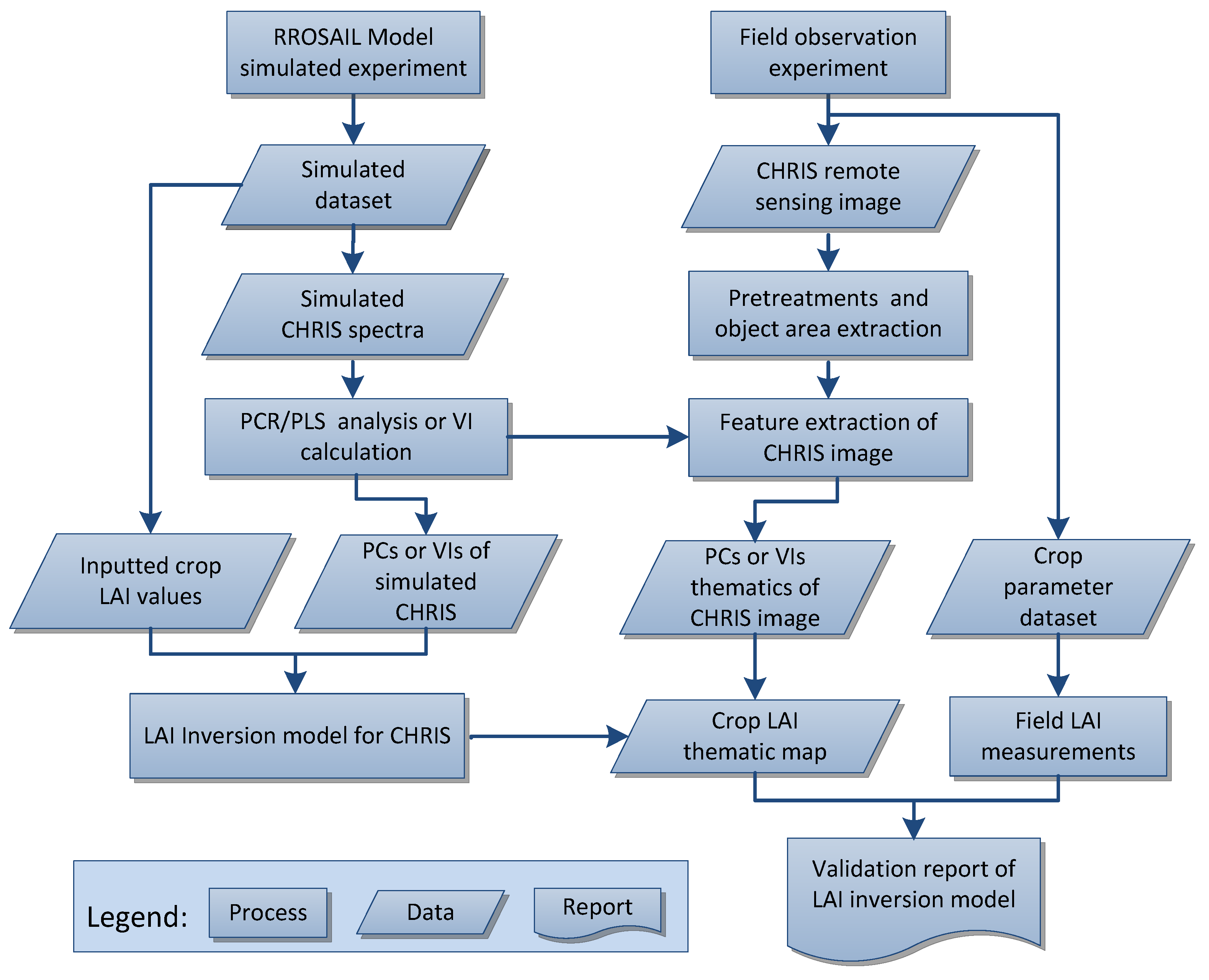
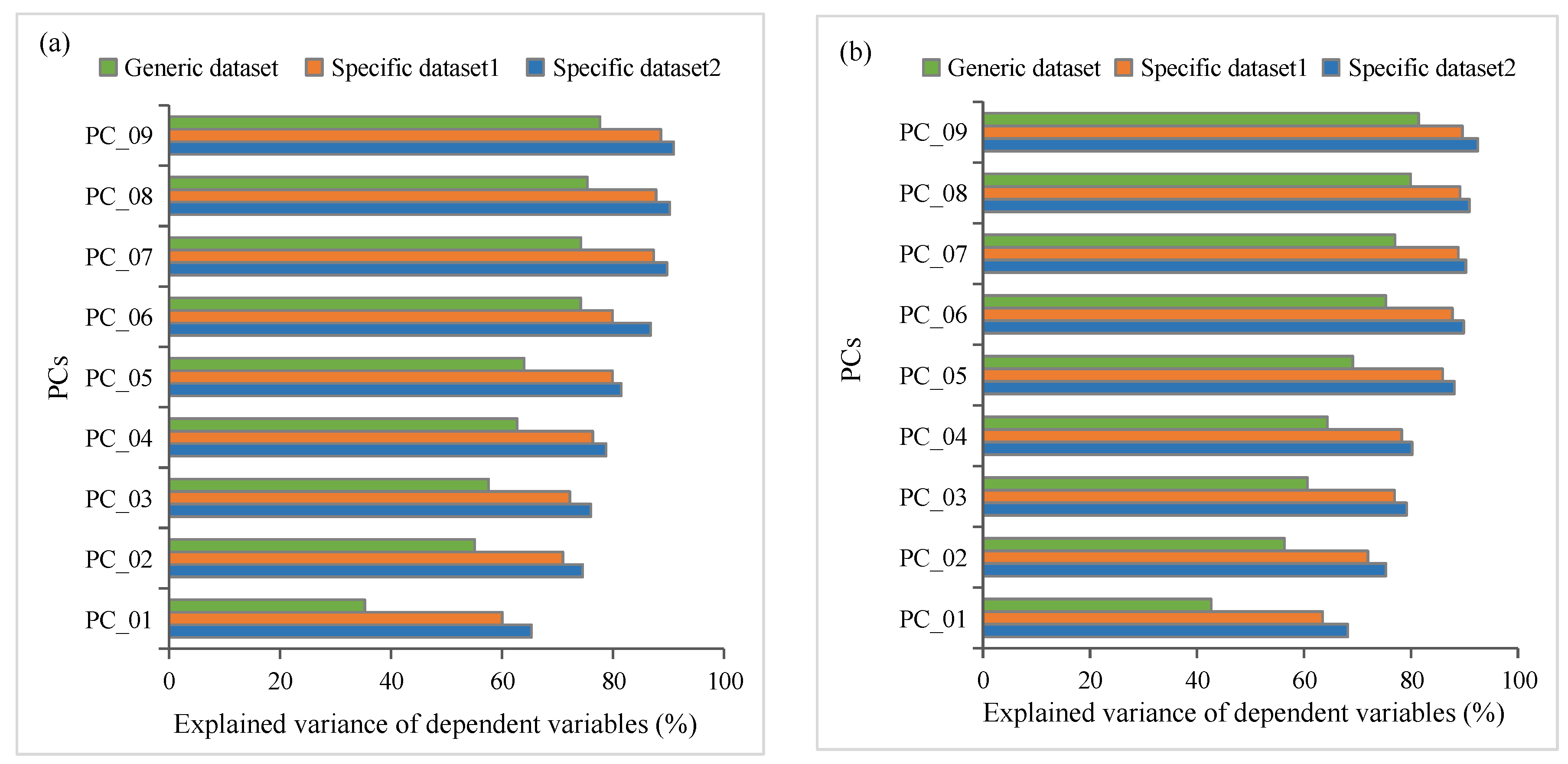
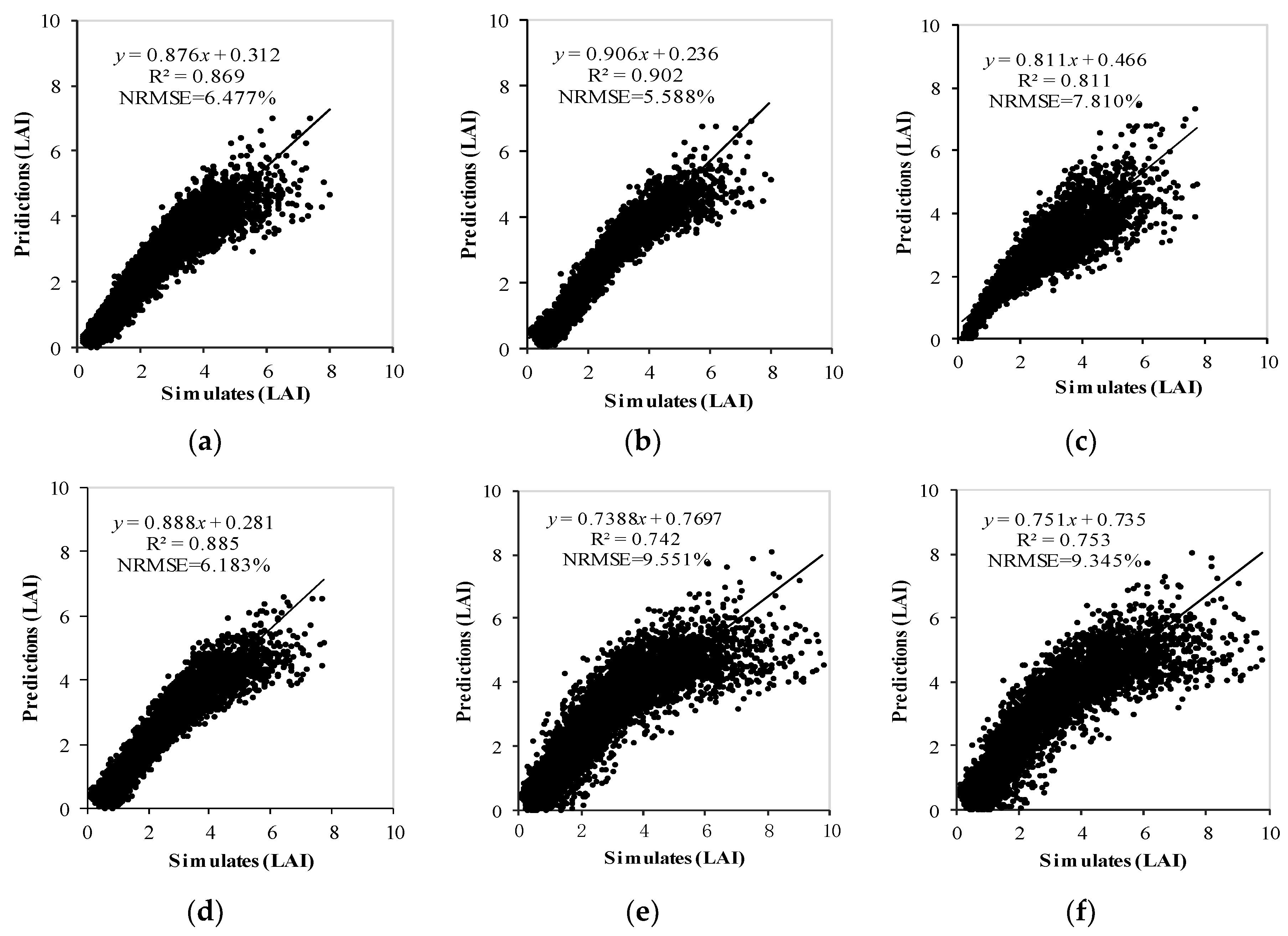
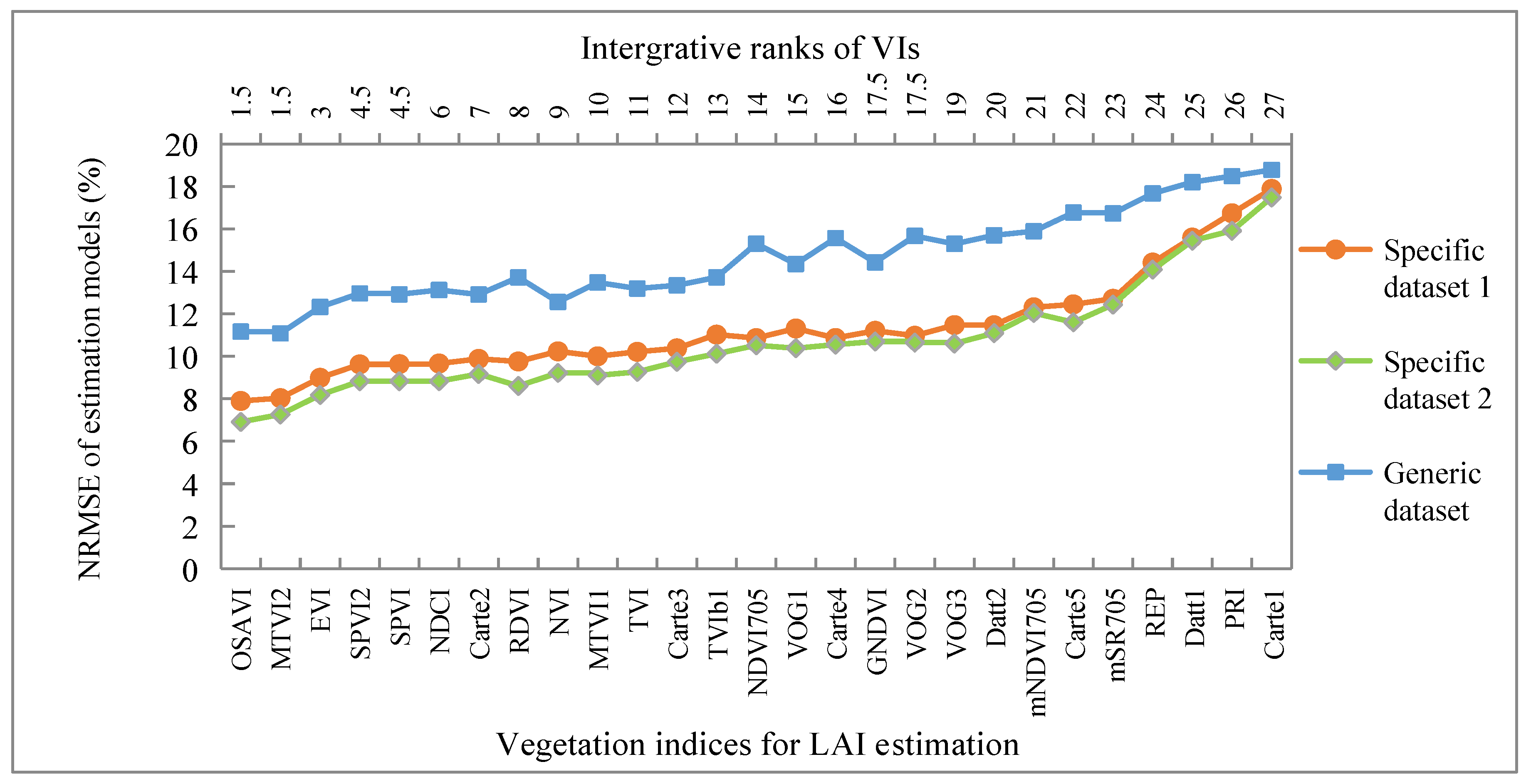
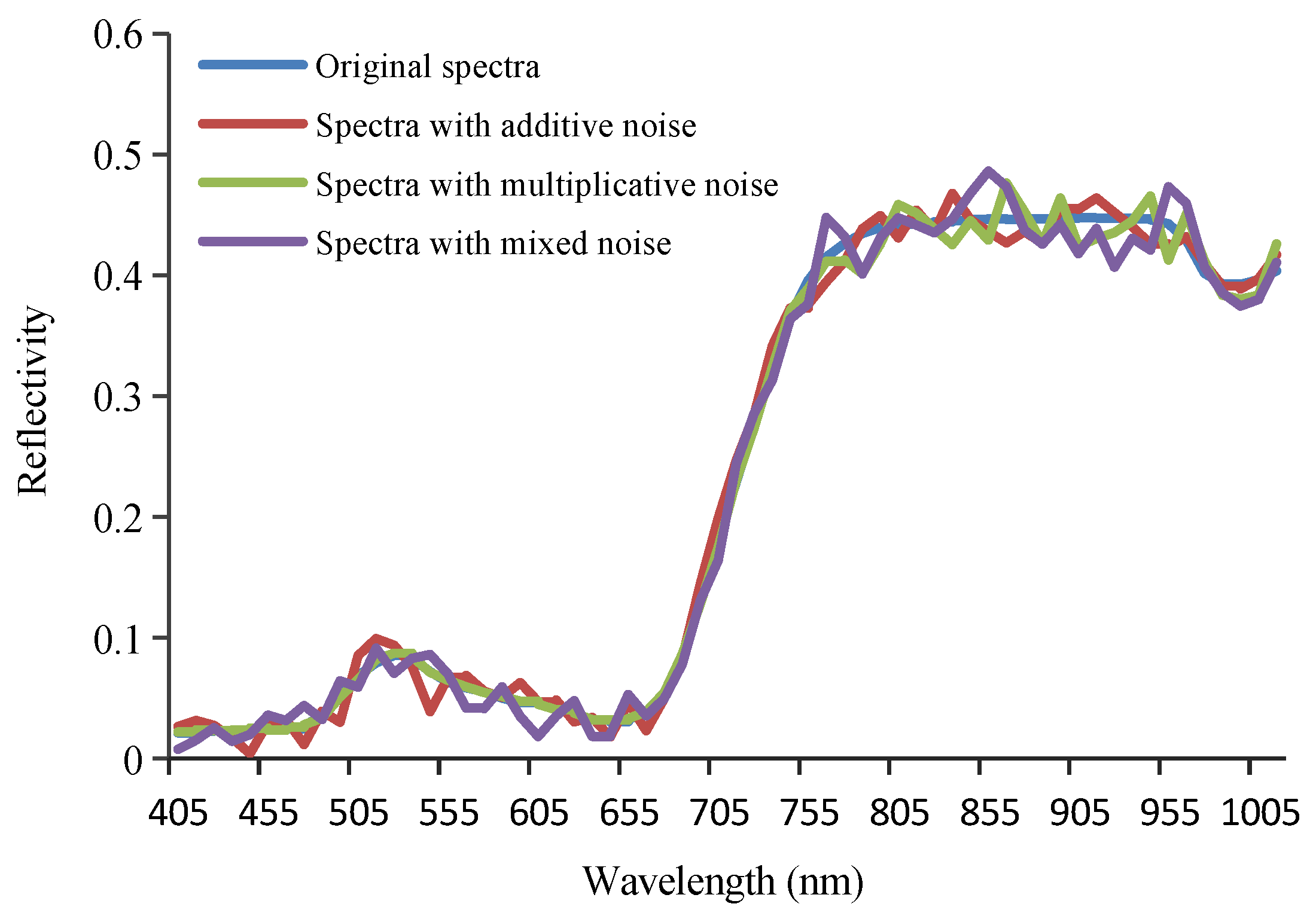
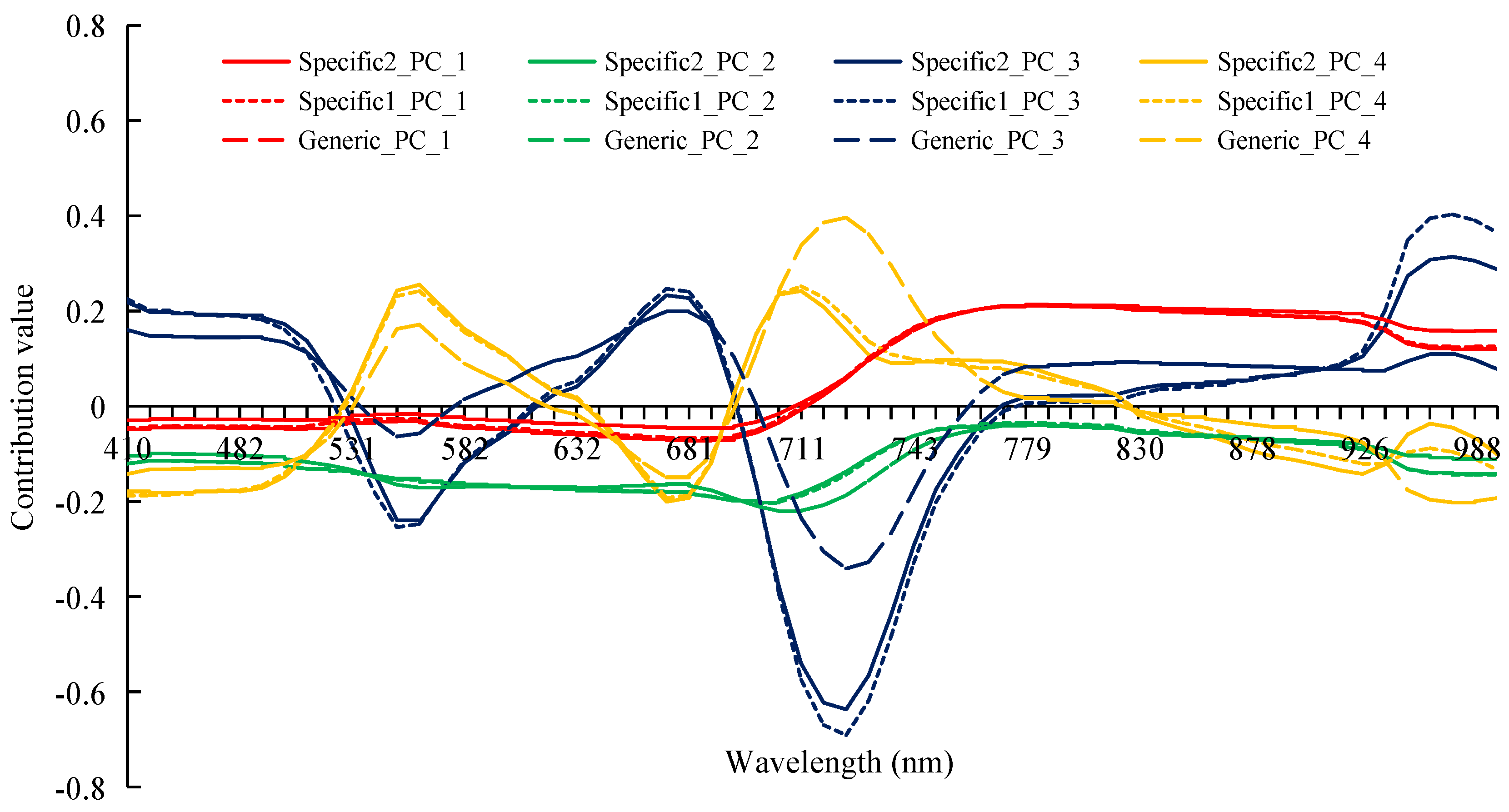
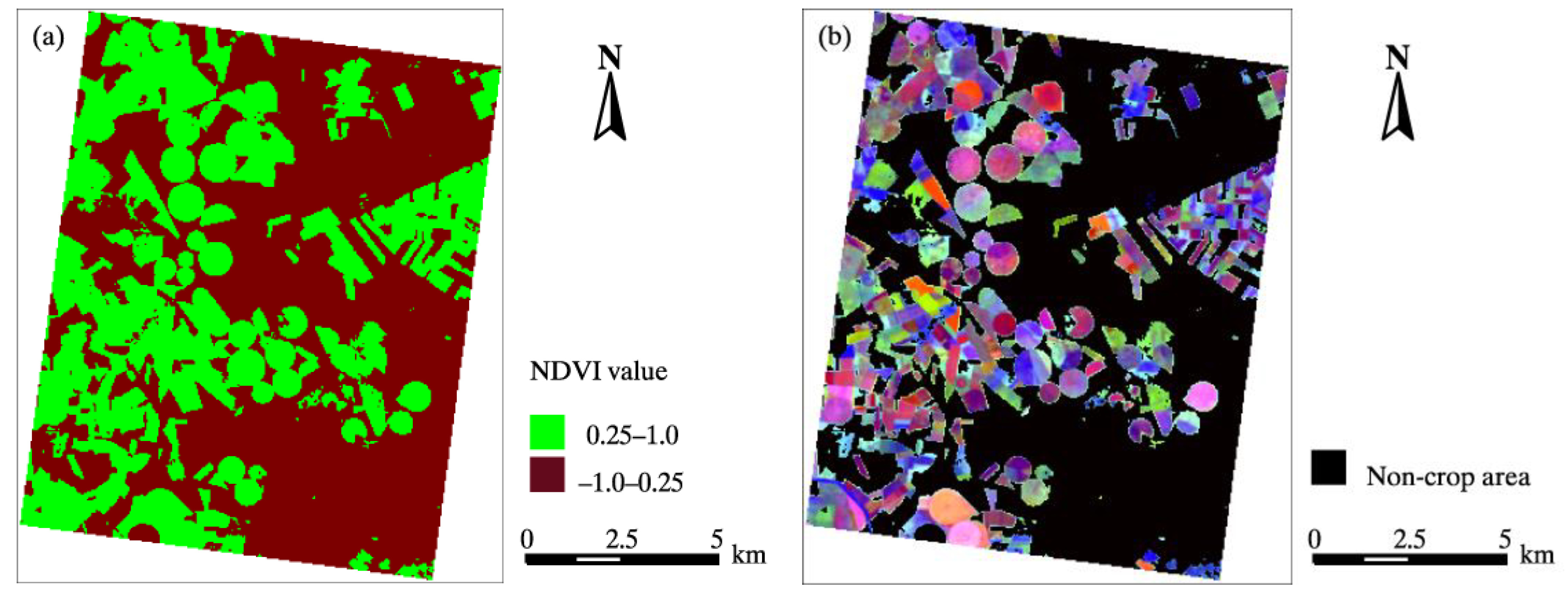
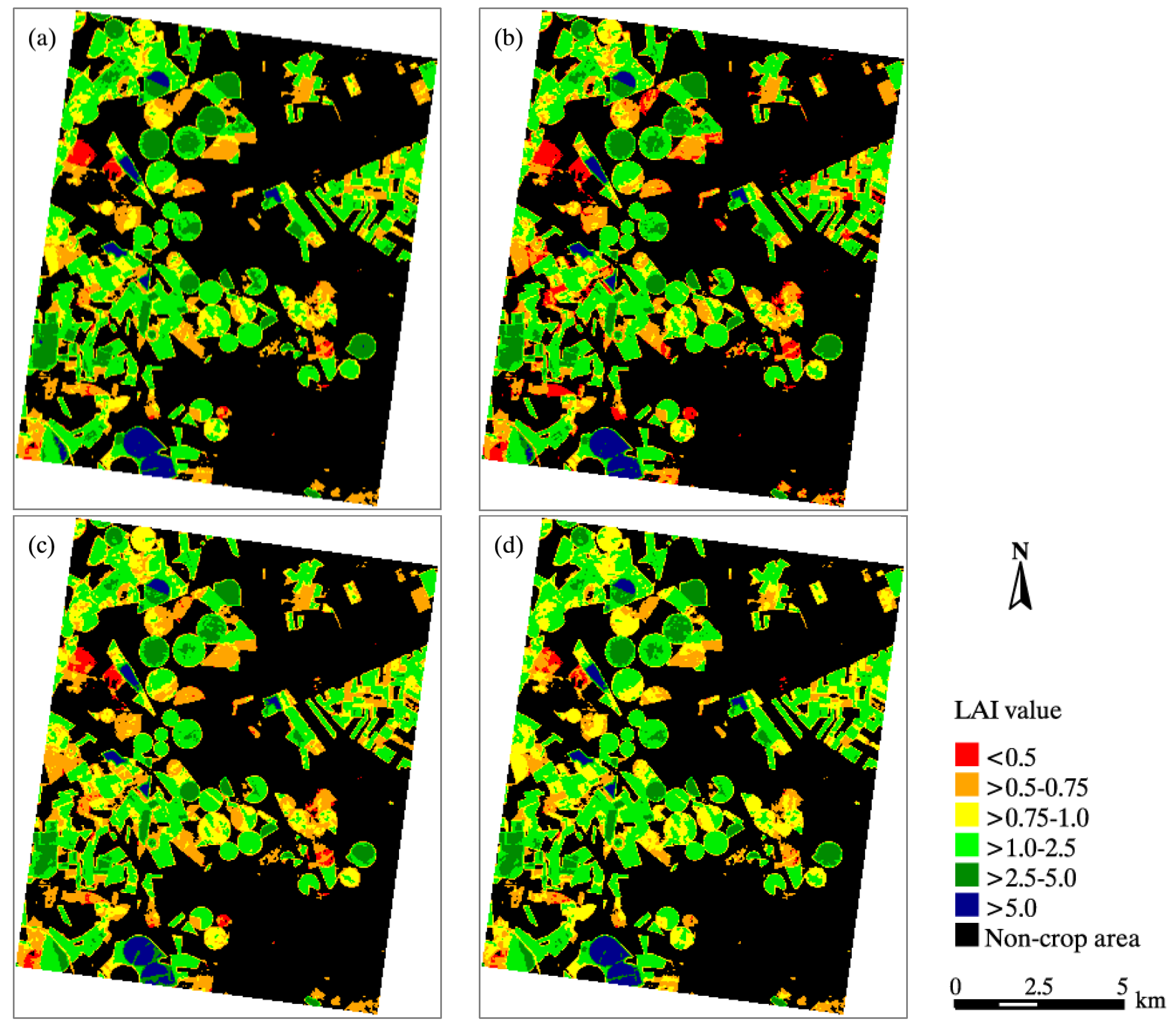
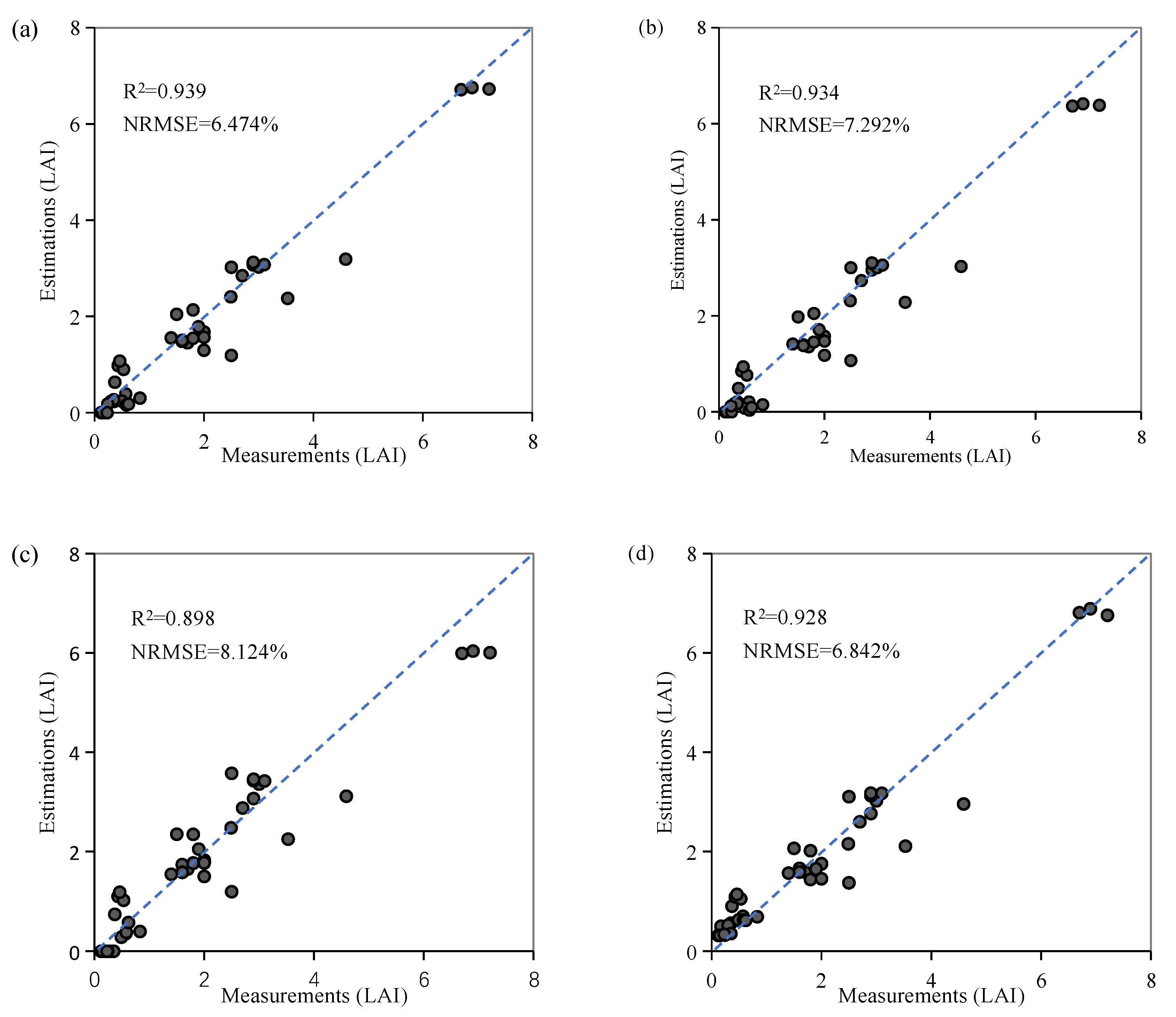
| Model Parameters | Abb. | Generic Dataset | Specific Dataset 1 | Specific Dataset 2 | ||||||
|---|---|---|---|---|---|---|---|---|---|---|
| Value Range | Mean | Std. Dev. | Value Range | Mean | Std. Dev. | Value Range | Mean | Std. Dev. | ||
| PROSPECT | ||||||||||
| Leaf chlorophyll content | Cab (µg cm−2) | 10–90 | 40 | 20 | 10–50 | 33 | 6 | 10–50 | 33 | 6 |
| Carotenoid content | Car (µg cm−2) | 6–10 | 8 | 2 | 6–10 | 8 | 2 | 6–10 | 8 | 2 |
| Brown pigment | Cbp | Fixed (0) | Fixed (0) | Fixed (0) | ||||||
| Equivalent water thickness | Cw (cm) | 0.005–0.130 | 0.012 | 0.020 | 0.010–0.080 | 0.030 | 0.020 | 0.010–0.080 | 0.030 | 0.020 |
| Dry matter content | Cm (g cm−2) | 0.002–0.015 | 0.006 | 0.006 | 0.002–0.015 | 0.006 | 0.006 | 0.002–0.015 | 0.006 | 0.006 |
| Leaf structural parameter | N | 1.50–2.00 | 1.75 | 1.00 | 1.50–2.00 | 1.75 | 1.00 | 1.50–2.00 | 1.75 | 1.00 |
| SAIL | ||||||||||
| Leaf area index | LAI | 0.1–10.0 | 2.0 | 2.5 | 0.1–8.0 | 2.0 | 1.8 | 0.1–8.0 | 2.0 | 1.8 |
| Mean leaf inclination angle | angl (°) | 30–80 | 50 | 10 | 30–80 | 50 | 10 | 30–80 | 50 | 10 |
| Soil brightness parameter | Psoil | 0.2–0.9 | 0.7 | 0.4 | 0.2–0.9 | 0.7 | 0.4 | 0.2–0.9 | 0.7 | 0.4 |
| Fraction of diffuse solar radiation | skyl (%) | 0–40 | 0–40 | 20 | 20 | Fixed (15.00) | ||||
| Solar zenith angle | tts (°) | 0–60 | 0–60 | 30 | 30 | Fixed (30.00) | ||||
| Viewing zenith angle | Tto (°) | 0–60 | 0–60 | 30 | 30 | Fixed (13.31) | ||||
| Relative azimuth angle | psi (°) | 0–180 | 0–180 | 90 | 90 | Fixed (138.08) | ||||
| Parameters | Samples | Mean Value | Standard Deviation | Value Range |
|---|---|---|---|---|
| LCC (µg cm−2) | 44 | 32.66 | 5.94 | 15.50–41.20 |
| EWT (cm) | 39 | 0.029 | 0.020 | 0.012–0.074 |
| LAI | 42 | 1.91 | 1.80 | 0.12–7.21 |
| Dataset Type | Feature Extraction Method | Model Algorithm | Validation Dataset with No Noise | Validation Dataset with Additive Noise a | Validation Dataset with Proportional Noise b | Validation Dataset with Mixed Noise c | ||||
|---|---|---|---|---|---|---|---|---|---|---|
| R2 | NRMSE | R2 | NRMSE | R2 | NRMSE | R2 | NRMSE | |||
| Specific dataset 2 | VIs | Curve fitting_EVI | 0.804 | 8.025 | 0.623 | 12.291 | 0.758 | 8.954 | 0.612 | 12.494 |
| Curve fitting_MTVI2 | 0.856 | 6.861 | 0.355 | 26.620 | 0.815 | 7.739 | 0.340 | 27.430 | ||
| Curve fitting_OSAVI | 0.850 | 7.038 | 0.703 | 10.291 | 0.810 | 7.904 | 0.702 | 10.304 | ||
| BP-ANN_OSAVI | 0.857 | 6.835 | 0.701 | 10.312 | 0.804 | 7.952 | 0.695 | 10.354 | ||
| LS-SVR_OSAVI | 0.853 | 6.924 | 0.704 | 10.228 | 0.811 | 7.915 | 0.704 | 10.253 | ||
| RFR_OSAVI | 0.923 | 5.183 | 0.803 | 8.094 | 0.867 | 6.505 | 0.801 | 8.161 | ||
| PLS | PLS_1PC | 0.687 | 10.114 | 0.686 | 10.127 | 0.687 | 10.127 | 0.686 | 10.127 | |
| PLS_2PCs | 0.757 | 8.911 | 0.756 | 8.937 | 0.757 | 8.924 | 0.756 | 8.949 | ||
| PLS_3PCs | 0.796 | 8.177 | 0.791 | 8.266 | 0.790 | 8.278 | 0.788 | 8.329 | ||
| PLS_4PCs | 0.805 | 7.987 | 0.797 | 8.152 | 0.794 | 8.215 | 0.787 | 8.342 | ||
| PLS_5PCs | 0.884 | 6.165 | 0.587 | 11.620 | 0.549 | 12.152 | 0.528 | 15.342 | ||
| PLS_6PCs | 0.902 | 5.646 | 0.429 | 13.671 | 0.268 | 15.468 | 0.187 | 19.494 | ||
| BP-ANN_4PCs | 0.854 | 6.899 | 0.790 | 8.316 | 0.803 | 8.038 | 0.740 | 9.291 | ||
| LS-SVR_4PCs | 0.837 | 7.443 | 0.821 | 7.734 | 0.828 | 7.582 | 0.815 | 7.823 | ||
| PFR_4PCs | 0.945 | 4.768 | 0.908 | 5.574 | 0.915 | 5.372 | 0.901 | 5.651 | ||
| Specific dataset 1 | VIs | Curve fitting EVI | 0.764 | 8.835 | 0.589 | 12.747 | 0.731 | 9.476 | 0.580 | 12.962 |
| Curve fitting_MTVI2 | 0.821 | 7.671 | 0.344 | 26.819 | 0.782 | 8.486 | 0.328 | 27.532 | ||
| Curve fitting_OSAVI | 0.820 | 7.734 | 0.693 | 10.873 | 0.791 | 8.337 | 0.682 | 11.076 | ||
| BP-ANN_OSAVI | 0.826 | 7.570 | 0.679 | 10.899 | 0.774 | 8.823 | 0.667 | 11.139 | ||
| LS-SVR_OSAVI | 0.823 | 7.886 | 0.683 | 11.203 | 0.792 | 8.464 | 0.671 | 11.418 | ||
| RFR_OSAVI | 0.902 | 5.581 | 0.783 | 8.476 | 0.867 | 6.505 | 0.767 | 8.827 | ||
| PLS | PLS_1PCs | 0.642 | 10.861 | 0.641 | 10.873 | 0.642 | 10.861 | 0.641 | 10.873 | |
| PLS_2PCs | 0.728 | 9.468 | 0.727 | 9.494 | 0.729 | 9.468 | 0.728 | 9.481 | ||
| PLS_3PCs | 0.782 | 8.481 | 0.775 | 8.608 | 0.774 | 8.633 | 0.773 | 8.646 | ||
| PLS_4PCs | 0.795 | 8.215 | 0.781 | 8.506 | 0.783 | 8.456 | 0.776 | 8.595 | ||
| PLS_5PCs | 0.868 | 6.582 | 0.612 | 11.316 | 0.630 | 11.051 | 0.377 | 14.342 | ||
| PLS_6PCs | 0.885 | 6.152 | 0.456 | 13.392 | 0.352 | 14.620 | 0.193 | 18.899 | ||
| BP-ANN_4PCs | 0.822 | 7.671 | 0.751 | 9.114 | 0.762 | 8.899 | 0.680 | 10.443 | ||
| LS-SVR_4PCs | 0.810 | 8.013 | 0.802 | 8.139 | 0.806 | 8.076 | 0.800 | 8.152 | ||
| RFR_4PCs | 0.926 | 5.164 | 0.896 | 5.772 | 0.906 | 5.573 | 0.890 | 5.881 | ||
| Generic dataset | VIs | Curve fitting_EVI | 0.574 | 12.273 | 0.488 | 13.636 | 0.567 | 12.374 | 0.477 | 13.828 |
| Curve fitting_MTVI2 | 0.658 | 11.010 | 0.349 | 22.808 | 0.652 | 11.101 | 0.324 | 22.747 | ||
| Curve fitting_OSAVI | 0.657 | 11.000 | 0.588 | 12.222 | 0.652 | 11.081 | 0.573 | 12.455 | ||
| BP-ANN_OSAVI | 0.660 | 10.949 | 0.569 | 12.323 | 0.647 | 11.251 | 0.558 | 12.505 | ||
| LS-SVR_OSAVI | 0.658 | 11.172 | 0.585 | 12.131 | 0.651 | 11.232 | 0.570 | 12.364 | ||
| RFR_OSAVI | 0.856 | 7.983 | 0.723 | 10.535 | 0.731 | 10.382 | 0.714 | 10.326 | ||
| PLS | PLS_1PCs | 0.429 | 14.202 | 0.429 | 14.192 | 0.429 | 14.202 | 0.428 | 14.212 | |
| PLS_2PCs | 0.568 | 12.354 | 0.567 | 12.364 | 0.567 | 12.354 | 0.565 | 12.384 | ||
| PLS_3PCs | 0.608 | 11.758 | 0.606 | 11.788 | 0.606 | 16.838 | 0.602 | 11.859 | ||
| PLS_4PCs | 0.643 | 11.222 | 0.634 | 11.374 | 0.633 | 11.374 | 0.618 | 11.616 | ||
| PLS_5PCs | 0.694 | 10.394 | 0.623 | 11.535 | 0.630 | 11.434 | 0.546 | 12.646 | ||
| PLS_6PCs | 0.752 | 9.343 | 0.390 | 14.677 | 0.273 | 16.020 | 017 | 19.879 | ||
| BP-ANN_4PCs | 0.727 | 10.047 | 0.690 | 10.758 | 0.706 | 10.284 | 0.656 | 11.374 | ||
| LS-SVR_4PCs | 0.726 | 10.051 | 0.709 | 10.303 | 0.713 | 10.242 | 0.688 | 10.626 | ||
| RFR_4PCs | 0.874 | 7.637 | 0.842 | 8.184 | 0.851 | 8.234 | 0.833 | 8.343 | ||
Publisher’s Note: MDPI stays neutral with regard to jurisdictional claims in published maps and institutional affiliations. |
© 2020 by the authors. Licensee MDPI, Basel, Switzerland. This article is an open access article distributed under the terms and conditions of the Creative Commons Attribution (CC BY) license (http://creativecommons.org/licenses/by/4.0/).
Share and Cite
Liang, L.; Geng, D.; Yan, J.; Qiu, S.; Di, L.; Wang, S.; Xu, L.; Wang, L.; Kang, J.; Li, L. Estimating Crop LAI Using Spectral Feature Extraction and the Hybrid Inversion Method. Remote Sens. 2020, 12, 3534. https://doi.org/10.3390/rs12213534
Liang L, Geng D, Yan J, Qiu S, Di L, Wang S, Xu L, Wang L, Kang J, Li L. Estimating Crop LAI Using Spectral Feature Extraction and the Hybrid Inversion Method. Remote Sensing. 2020; 12(21):3534. https://doi.org/10.3390/rs12213534
Chicago/Turabian StyleLiang, Liang, Di Geng, Juan Yan, Siyi Qiu, Liping Di, Shuguo Wang, Lu Xu, Lijuan Wang, Jianrong Kang, and Li Li. 2020. "Estimating Crop LAI Using Spectral Feature Extraction and the Hybrid Inversion Method" Remote Sensing 12, no. 21: 3534. https://doi.org/10.3390/rs12213534
APA StyleLiang, L., Geng, D., Yan, J., Qiu, S., Di, L., Wang, S., Xu, L., Wang, L., Kang, J., & Li, L. (2020). Estimating Crop LAI Using Spectral Feature Extraction and the Hybrid Inversion Method. Remote Sensing, 12(21), 3534. https://doi.org/10.3390/rs12213534





